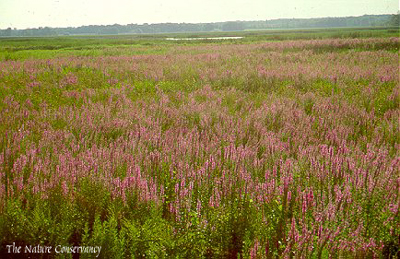|
Purple
loosestrife

|
|
Lythrum
salicaria
|
|
Phragmites

|
|
|
|
European Honeysuckle
|
|
Jewel Weed
|
|
Butter & eggs
|
|
Multifloral rose
|
|
|
|
|
|
What is an invasive
species?
Invasive species are exotic or foreign
species that invade habitats and displace native species.
The degree to which a plant or animal is invasive or
destructive to a given habitat or ecosystem, depends upon
the attributes of the invasive population as well as the
environment in which they have established themselves.
Commonly, invasive species can dominate a habitat because
their populations are not constrained by natural predators.
Zebra mussel populations have exploded in the Hudson River
and the Great Lakes due to a lack of predation. In the case
of plants, there are hundreds of European and Asian floral
species that have established multiple populations across
the U.S.
The general mobility of life is a natural
phenomenon. Since the beginning of what we define as life,
plants, animals, and other organisms have migrated across
various regions of the globe, creating biological diversity.
The Galapagos Islands, revered for its finches and other
feats of evolution, is an island colonized by exotic species
from Ecuador, Peru, and other regions of Central and South
America. We learn the principles of gene flow as a natural
means of exchanging genetic information between spatially or
temporally separated populations and creating variation
within those populations. So, if the movement of organisms
is "natural" or "normal" or simply something that’s
been going on for 4 billion years, how did invasion become a
detrimental force on the environment? What makes a
population of organisms invasive?
There seem to be two main attributes to
the growing problem with invasive species. The first is the
high rate of introduction of exotic species; the second is
the rapid destruction and clearing of native habitats which
allows for the infiltration of exotic populations. The
increasing mobility of people, especially over the past two
hundred years has drastically increased the number of exotic
plants and animals introduced into the U.S. Boats carry
mussels, barnacles and algae from Europe on their hulls, and
nurseries import exotic flora to be planted in front of
suburban dream homes. The American marine and terrestrial
systems have been bombarded by non-natives, and communities
across the states are currently trying to deal with their
domination of native habitats. Thus, what part of makes
invasive species a problem is the fact that humans are
continually bombarding their environments with high numbers
of exotic species at a rate that the environment cannot
recover from. The clearing of natural habitats essentially
makes room for invasive species. There is a human-induced
biological crisis, many would argue, whereby extinction
rates are high and thus the loss of biological diversity is
devastating.
How does invasion happen?
Invasive species are introduced to
environments in which their natural constraints may not
exist. Natural predators that would control population
explosion may not be present; climactic constraints,
diseases, and other species competing for similar resources,
may be absent or lessened in the foreign environment.
Furthermore, intrinsic traits of invasive species, such as
high seed production, high pollen production, and general
plant vigor may allow for domination of a habitat and
displacement of native species. The aggressive
introduction of the vigorous plant, Purple
loosestrife, to wetland habitats is a classic example of
introduction by a lack of herbivory and competition.
Why do we care about wetland
diversity?
Wetlands are vital habitats that have
been especially targeted in the manipulation of American
landscapes. Because so many wetland areas have been
disturbed by human activity, they are highly vulnerable to
invasion by non-native species. Exotic species that crowd
out native flora threaten not only the existence of endemic
wetland flora, but also threaten the survivorship of birds,
insects and other organisms that depend upon native wetland
species. Invasive species can disrupt an entire wetland
ecosystem. In order to determine the threat of invasive
species to the survival of wetlands, we must understand the
functions of wetlands and how those functions can be
disrupted by the introduction and subsequent domination of
exotic species. [Connect to wetland ecology
site]
Link to http://tncweeds.ucdavis.edu/worst.html
|


